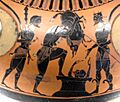Antimenes Painter facts for kids
The Antimenes Painter was a talented artist from ancient Attica (a region in Ancient Greece). He painted vases using a special technique called the black-figure style. He was active around 530 to 510 BC.
The real name of the Antimenes Painter is not known today. We call him the "Antimenes Painter" because of a special message, called a Kalos inscription, found on one of his vases. This message said "Antimenes is beautiful" and was on a type of vase called a hydria (a water jar) now in a museum in Leyden.
About 150 of his artworks have been identified. Most of these are hydriai and regular amphorae (large storage jars). Many of his vases were found in Etruria, an ancient region in what is now Italy. Experts believe he worked closely with the pottery workshop of Andokides.
What He Painted
The Antimenes Painter often showed popular stories and scenes from his time. He painted:
- The exciting adventures of the hero Herakles
- The god Dionysos and his lively companions
- Scenes with chariots, which were like ancient racing cars
He was good at changing up these themes and making his pictures look very organized. He also liked to add small, peaceful details to his main stories. For example, one of his hydria vases shows a scene at a well, and an amphora in the British Museum in London shows people harvesting olives. These small details make his work special.
His Artistic Style
His way of drawing was similar to another artist named Psiax. You can also see that he was influenced by the early red-figure style, which was a newer painting technique at the time. Even so, he kept using the older black-figure technique, which was still very popular. It can be hard to tell his work apart from other painters who worked with him. Some of his later pieces are known for their very fine and expressive drawings.
See also
 In Spanish: Pintor de Antimenes para niños
In Spanish: Pintor de Antimenes para niños
- List of Greek vase painters
Images for kids
-
Olive gathering, amphora, around 520 BC. British Museum.
-
Herakles, Eurystheus and the Erymanthian Boar. Side A from an Ancient Greek black-figured amphora painted by Antimenes, about 525 BC, from Etruria. Louvre, Paris.




